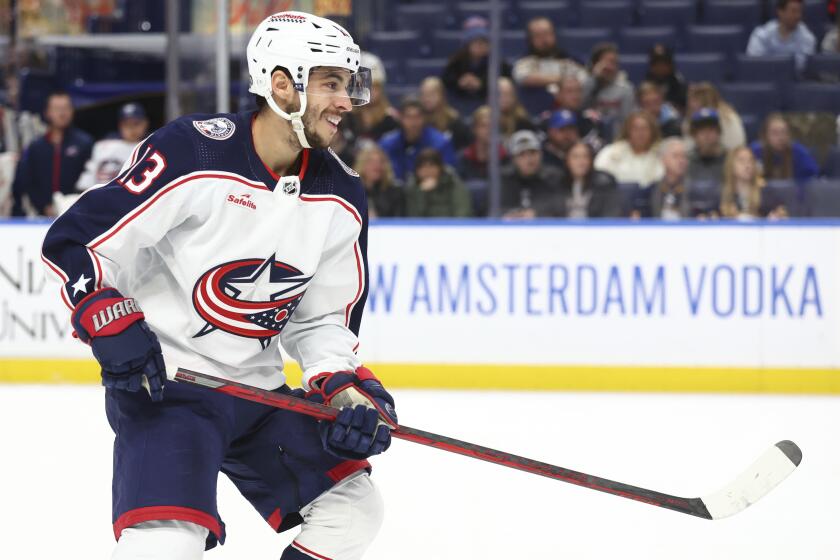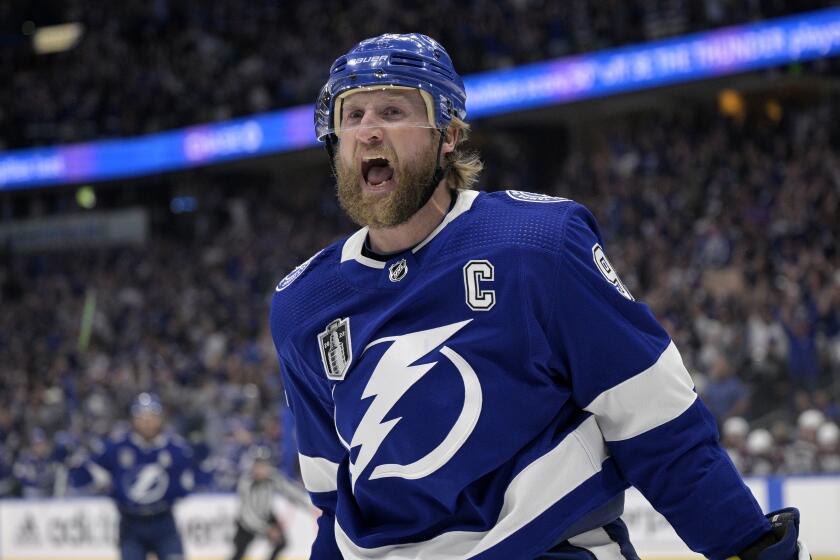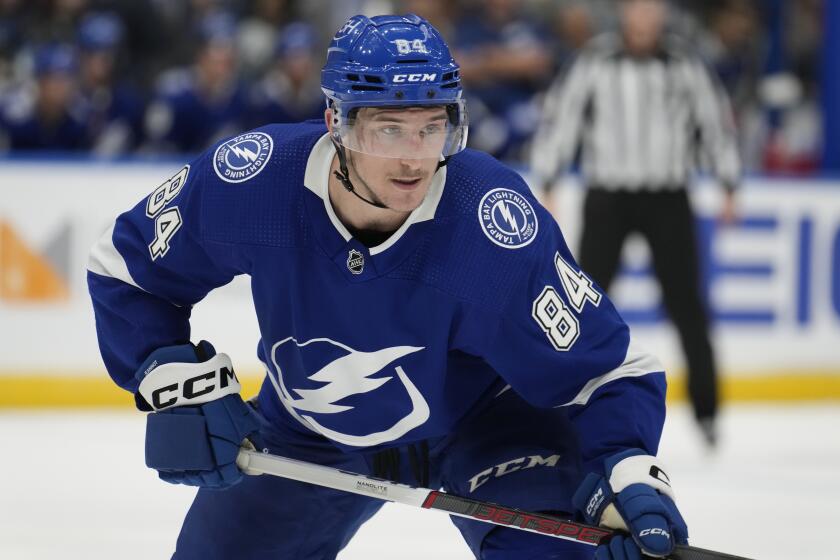Labor Pains Finally Stop for the NHL
The National Hockey League and the players’ association on Wednesday announced they had agreed in principle on a new collective bargaining agreement, ending a bitter battle that wiped out the 2004-05 season and weakened the sport’s tenuous hold on the American sports audience.
The six-year agreement, which the union can open for renegotiation after the fourth year, is subject to ratification by players and the NHL’s Board of Governors. The union scheduled a meeting in Toronto for next Wednesday and Thursday for debate and vote; the governors will gather next Thursday in New York, where they’re expected to rubber-stamp a deal that for the first time gives teams a salary cap and other limits as tools to manage spending.
If both sides approve, training camps will open as usual in mid-September and the season will start in early October.
Players had vowed they’d never accept a cap or a system that linked payrolls to league-wide revenues, contending that teams should be allowed to determine their own budgets and that owners couldn’t be trusted to accurately report revenues. However, the union had no choice but to accept punitive restraints in the face of owners’ surprising solidarity and Commissioner Gary Bettman’s unwavering insistence upon cost certainty.
“The hard work starts now,” said King President Tim Leiweke, a member of the NHL’s executive committee and vocal advocate of overhauling the NHL’s economics.
“First, this has to get ratified, and second, we do not underestimate how we have to rebuild the bridge with our fans. But I’m absolutely convinced that we will come back stronger than ever.”
Talks that began on the 300th day of the lockout and lasted all night produced the accord, which was announced in terse and identical press releases issued by the league and the union. Terms were not specified, and neither side commented. General managers were invited to an informational meeting in New York this weekend to examine a 600-page document that will transform the way they do business.
“This is going to put everybody in a situation where they have a chance to compete,” said Lou Lamoriello, general manager of the New Jersey Devils and an occasional member of the NHL’s negotiating team. “Something had to be done, and the intent is to put people on a more level footing.”
Sources told The Times that the sides had agreed in principle last week but that an outcry from players led the union to request sweeter terms in several areas. Some numbers were adjusted, as in reducing the age for unrestricted free agency to 27 from 28 by the end of the deal, and increasing the amount teams will pay to the pension funds of current and past players.
The deal centers on a salary cap that in the first year will have a limit of about $37 million, excluding costs of players’ medical and dental benefits, insurance and pensions, and a floor of about $24 million. Existing contracts will be devalued by 24%, and teams will have a chance to buy players out for two-thirds the reduced amount.
No player will earn more than 20% of the salary cap figure in a season, meaning that a $37-million cap would create a maximum salary of $7.4 million for any player. Also, the entry-level system will be extended from three years to four and those salaries will be limited to $850,000, to be supplemented by bonuses that will be difficult to achieve. Sources have also said that bonuses for all players will be standardized and will be based on criteria specific to the player’s position.
League-wide player costs cannot exceed 54% of league-wide revenues in the first year. That threshold will rise or fall in concert with revenues. To ensure that the negotiated level is met, a portion of players’ salaries will be diverted into an escrow fund. If player costs exceed 54%, teams will get the difference. If spending is less, the money will go back to players.
Clubs will also share revenues, with the top 10 revenue-producing clubs contributing to a fund from which the bottom 10 can draw. That eliminated the need for a luxury tax.
The agreement represents a resounding victory for owners, who claimed they’d lost $1 billion over the decade that preceded the lockout.
“From an agent’s point of view and representing players for 25 years, I’d have to say the landscape is substantially prohibitive,” said Los Angeles-based Ron Salcer. “From the players’ point of view, it’s disappointing that the 24% [rollback] that was initially given in lieu of a cap is part and parcel of the agreement.”
Tom Laidlaw, a former NHL defenseman who is an agent for 10 players, said, “We did something that was terrible for our business and our sport. Not just shutting down the sport, but it got embarrassing. Now that the CBA is done, let’s put the old disagreements on the shelf and go out and promote the game again.
“When you’re tied at the hip with revenue sharing, it’s in everybody’s best interest to promote the sport.”
Players see the chance to gain unrestricted free agency sooner than under the previous deal as an important victory that could balance the many points they lost. The age will be 31 in the first year of the deal and gradually recede to 27.
“The salary cap, that’s one thing, but the ability to play where you want to play, where you will be happy, that in itself is more important,” New Jersey forward Jeff Friesen said. “You see guys whose careers have been ruined because they were not given an opportunity. In a more free market, whether you do it under a cap or not, it gives guys the opportunity to go where they can be successful.”
Former King Ian Laperriere said he expects players to ratify the deal.
“We’re hungry to play hockey. ... They locked us out for a year, telling us we’re not going to allow you to do what you’ve been doing the last 25 years,” he said. “Now they are giving us a chance to get back on the ice and do what we love to do. I don’t think there will be hard feelings between us and the owners. We need to leave that in the past and go about bringing our business up, put on a good show on the ice.”
The agreement contains a provision that will allow players to represent their homelands at the Turin Olympics next February. A spokesman for USA Hockey said the U.S. staff could be announced shortly after the deal is ratified. Team Canada had conditionally invited NHL players to a training camp and can firm its plans next week.
The annual entry draft, which this year will showcase scoring sensation Sidney Crosby, will be held July 30 in Ottawa, Canada. A draft lottery will be held after the governor’s expected ratification next Thursday. Each team will have one ball in the lottery, but teams that have missed the playoffs each of the last three seasons -- the New York Rangers, Pittsburgh Penguins, Buffalo Sabres and Columbus Blue Jackets -- will get three chances. Other teams, such as the Kings and Mighty Ducks, will get two balls in the lottery.
While each side explains the agreement to its constituents, the NHL is preparing a massive public relations campaign and new rules designed to enhance scoring. Elbowing its way back to prominence looms as a major challenge for the NHL, whose long-standing relationship with ESPN ended when the cable network declined to exercise a $60-million contract option.
Bettman locked players out on Sept. 15, 2004. A league-commissioned report released in February, 2004 by Arthur Levitt, former head of the Securities and Exchange Commission, calculated that clubs’ losses reached $273 million in 2002-03 and that 75% of league revenues were going toward player costs, putting the NHL “on a treadmill to obscurity.”
The union disputed those figures and not until recently did the two sides jointly examine the report and agree on the definition of hockey-related revenues.
“I appreciate the frustration fans have gone through. We’ve all gone through it in different degrees,” said Lamoriello, who added he was “pleasantly surprised” by the enthusiastic e-mails and calls to the team’s office after Wednesday’s announcement.
“The important thing is that here we are. Both parties spent more than 300 days doing this deal, so we know it must be fair. You don’t put in that amount of time and come out with a deal that’s not fair.
“We have to transmit to our fans, players, sponsors and scouts that everybody has to get on the same page and not look back. If we get that unity, only positive things will result.”
King forward Sean Avery, who last week apologized to fans and said players had been “brainwashed” by the union’s leadership, acknowledged the deal was far from great for players.
“I feel good. It’s a good thing we waited a year for this,” he said, laughing to emphasize his sarcasm. “I’m excited, there’s a future to look at and we’re going to have hockey again.
“The whole point of this is we thought we weren’t going to have a salary cap.... We thought we were going to prevail, but at this point, why even worry about it, we have to move on.”
Times staff writers Chris Foster and Lisa Dillman contributed to this report.
*
(BEGIN TEXT OF INFOBOX)
NHL lockout chronology
Highlights from a chronology of events in the NHL lockout:
2003
* Jan. 6 -- NHL Players’ Assn. Executive Director Bob Goodenow and Commissioner Gary Bettman quietly hold first collective bargaining talks pertaining to expiration of current deal.
* March 26 -- Eight consecutive meetings are secretly held between top lieutenants and lawyers from both sides. Those involved include: Ted Saskin, NHLPA senior director, and John McCambridge, union outside counsel, on the players’ side; Bill Daly, NHL executive vice president and chief legal officer, and Bob Batterman, league outside counsel, on the owners’ side. Other sessions take place in Toronto and Philadelphia in April, and Ottawa and New York in May.
* June 4 -- The biggest gathering yet, again kept secret, with Goodenow and Bettman joining the talks, as well as Ian Pulver, NHLPA associate counsel, and David Zimmerman, NHL vice president and general counsel.
* Oct. 1 -- First meeting made public, includes players and owners. Union tables first proposal, offer that includes 5% salary rollback. League says no and counters by saying under any new system team payrolls can’t exceed $31 million -- the NHL’s first official salary cap threat.
2004
* Jan. 14 -- First talks in more than three months include Goodenow, Bettman, Saskin, Daly, McCambridge, Batterman, Pulver and Zimmerman.
* Feb. 12 -- Arthur Levitt releases his league-commissioned financial report, which says the NHL is on a “treadmill to obscurity” if player costs aren’t reduced. The report says only 11 of 30 teams were profitable in 2002-03, when total operating losses were $273 million. The union calls the report “flawed.”
* April 29-Sept. 9 -- Several meetings yield proposals but no agreements. League first points out desire for a “partnership/cost certain system for player compensation”; union reminds league of aversion to salary cap system.
* Sept. 15 -- Bettman announces lockout.
* Oct. 13 -- First official day of the NHL’s regular season missed.
* Dec. 9 -- Both sides arrive at talks with full complement of negotiating teams. Union surprises with offer highlighted by 24% salary rollback on all existing player contracts. Other givebacks in entry-level system, qualifying offers, salary arbitration and slightly better payroll tax, but no salary cap.
* Dec. 14 -- Negotiating teams meet again. The NHL rejects union’s proposal and offers a counterproposal, which union rejects. The league’s offer includes a salary cap, the scrapping of salary arbitration and the restructuring of the players’ 24% salary rollback.
2005
* Jan. 17 -- Trevor Linden, players’ executive committee president, invites both sides back to the negotiating table, but with a small group that does not include Bettman or Goodenow.
* Jan. 19-27 -- Small-group meetings held, some in secret, all with very little progress.
* Feb. 2-4 -- Marathon round of meetings featuring mix-and-match of representatives. League tables 15-point proposal, again featuring salary cap -- and NHLPA rejects it.
* Feb. 9 -- NHL surprises the union, Bettman calling Goodenow and asking whether they can meet. League offers “compromise” deal that union quickly rejects. Bettman finally announces there won’t be hockey unless a deal is put on paper by weekend.
* Feb. 10 -- NHL, NHLPA part ways, after bleak assessment of latest failed talks.
* Feb. 14 -- The NHL schedules a news conference for Feb. 16 during which it plans to cancel the season. Then, what looks like a breakthrough: The league drops its demand for a link between league revenue and player costs, and the players’ association agrees to accept a salary cap during talks in Niagara Falls, N.Y.
* Feb. 15 -- The sides trade a flurry of proposals and letters but can never agree on a cap. The owners bump up their offer of a $40-million cap to $42.5 million; the players’ counterproposal is for $49 million, which the league rejects out of hand.
* Feb. 16 -- Bettman cancels season.
* Feb. 19 -- The NHL and the union restart talks at an undisclosed location in New York featuring Wayne Gretzky and Mario Lemieux, but talks break down and leave the already canceled season totally lost.
* March 1 -- NHL hints at veiled threat of replacement players after Board of Governors’ meeting.
* March 11 -- NHL and the union meet for first time since the Feb. 19 emergency session.
* March 17 -- NHL makes two offers to union. 1) $37.5-million U.S. team-by-team salary cap offer. 2) A deal linking revenue to payrolls. The union doesn’t like either.
* March 25 -- NHL files a charge with the National Labor Relations Board in the United States against the NHLPA over a union policy that appears to financially penalize members who become replacement players. Daly calls the union policy, which states a member would have to pay back any work stoppage benefits if he chose to become a replacement player next season, “coercive” and in violation of “the players’ rights under the labor laws to decide individually whether to be represented by a union.”
* March 22-25 -- The NHLPA and players’ executive committee come up with idea of upper and lower limit on team-by-team payrolls. The idea eventually leads to the new collective bargaining agreement.
* April 4 -- The union introduces the idea from the March 22-25 meetings. The idea finds merit with the NHL, although both sides keep this private.
* April 19-20 -- More progress between NHL and union. No more threat of replacement players after another Board of Governors’ meeting.
* April 28 -- NHLPA applies for union certification in Quebec and British Columbia, moves intended to block the potential use of replacement players in those provinces.
* May 5 -- Talks resume, with both sides agreeing on a more aggressive schedule to get the deal done. They meet a total of 31 times in May and June.
* June 15 -- A British Columbia Labour Relations Board hearing into whether the NHLPA can be certified as a union in the province is put on hold. The NHLPA, citing recent progress in labor talks with the NHL, agrees to the league’s request to adjourn the proceedings.
* July 13 -- A tentative deal is reached after more than 24 straight hours of talks, the culmination of 10 consecutive days of meetings.
Associated Press
Go beyond the scoreboard
Get the latest on L.A.'s teams in the daily Sports Report newsletter.
You may occasionally receive promotional content from the Los Angeles Times.




